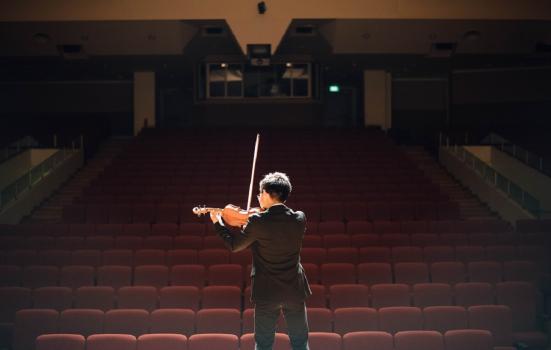Ben Walmsley, Abigail Gilmore and Dave O’Brien share findings from a research programme that shows there are silver linings among the storm clouds.

As part of the Centre for Cultural Value’s research into how Covid-19 is shifting and shaping the cultural sector, we are analysing labour force data from the Office for National Statistics, conducting a series of interviews with cultural practitioners, and undertaking an ecosystem analysis of Greater Manchester.
So far, the picture is mixed. The impact was always going to be devastating and the immediate shock severe. Inequities and inequalities that existed before anyone had heard about Covid-19 were inevitably going to be exacerbated. But like any crisis, the impacts are rarely all negative and we are certainly starting to see some interesting shifts in thinking across the sector from our early investigations – shifts that might lead to that elusive goal of enduring systemic change.
A shrinking sector
In terms of the national picture, we have gathered indubitable evidence of grim news for the arts and cultural sector. Working hours collapsed across the first three quarters of 2020. Lockdowns and phased reopenings curtailed the activities of even those creative jobs able to be done from home. Among sectors most dependent on live audiences like music and the performing and visual arts, the loss of hours rapidly translated into a loss of jobs: there was a 30% decline people working in these occupations over the middle of 2020. This equates to around 55,000 job losses across the sector. Moreover, the numbers leaving the creative sector were higher than average, even for a sector of the economy dominated by freelancers and characterised by high staff turnover because it’s such a project and gig-based part of the economy.
Campaigning groups have drawn particular attention to the plight of freelancers, who have not seen the same levels of government support as their more formally employed, furloughed colleagues. Our analysis suggests the impact on occupations in music and the performing and visual arts is especially grave because around 88% of workers in these sectors are in some form of self-employment. Self-employed workers also suffered a sharper drop in hours worked compared to more traditional employees. As a result, it is fair to conclude that the Government’s failure to support freelancers has inevitably failed those working in live arts, irrespective of the financial support offered to institutions through the Cultural Recovery Fund. This is likely to lead to a talent drain as creative skills are redeployed in other less volatile sectors. And this is before we consider the future impacts of Brexit...
Silver linings?
It has long been acknowledged that the arts and cultural sector is resistant to change. There are many reasons for this, ranging from inert leadership to poor investment in development and training, to the precarious nature of cultural work and the constant battle for organisational survival. The pandemic has accelerated change and propelled cultural organisations to finally reassess who and what they are really for. Amplified by Brexit and the Black Lives Matter movements, Covid-19 has forced cultural organisations to rethink their business models and re-address concepts of remit, relevance, resilience, risk, viability and engagement. Although some organisations have already been fatally wounded and many others have shrunk in size, the crisis is also fostering a renewed sense of cross-sectoral collaboration and collegiality among those who are lucky or robust enough to survive.
As one interviewee put it, Covid-19 has “turned up the dial” on existing race, gender, class, health, and geographic inequalities. This has led to increased attention to inclusion and access among cultural organisations, and a sense of campaigning. Although clearly and visibly exhausted, many cultural leaders and practitioners are starting to feel buoyed by the potential of the much vaunted ‘new normal’: they are investing in and experimenting with new technologies, trialing new business models, attending free webinars, learning about digital engagement, forming new peer groups, lobbying MPs and policymakers, and networking and collaborating online far more readily than they did or could before. There is a new sense of shared endeavour and of working in a sector that really matters.
Innovative ecosystems
This is perhaps most visible in local cultural ecosystems where, despite the need to pivot around constantly changing circumstances, there are signs that longer term strategic aims are less affected, and in some cases even strengthened. The value of arts and culture to place-making and wellbeing is being recognised by strategic partners, encouraging new commissioning models. Public realm works are animating city centres and high streets that have lost the footfall of office workers. Volunteers from third sector organisations have been delivering creative care kits. This may spell out further instrumentalism to some, but the newly cemented, quickly assembled partnerships formed to mitigate the impact of lockdowns and inform recovery may forge policy innovations that bring together a more agile public sector.
Such initiatives rely on the confidence of audiences, communities, and participants in navigating social distancing measures, digital delivery, and the ongoing trauma and grief caused by the pandemic. The need for robust intelligence on the propensities for cultural participation and engagement, with a particular focus on the excluded, unheard and vulnerable, is critical. Our integration of The Audience Agency’s Covid-19 Cultural Participation Monitor survey will help us take account of these factors in a dynamic way.
As our research progresses, we will maximise opportunities to collaborate and co-produce data and analysis. Working with our partners at the Creative Industries Policy and Evidence Centre, we will relay these findings to policy and sector stakeholders where and when they are most needed. The picture is emerging, and although it needs further exposure, it is certainly not black and white.
Ben Walmsley, Abigail Gilmore and Dave O’Brien are part of a large-scale research programme examining the impacts of Covid-19 on the cultural sector and implications for policy.
![]() @BenWalmsley | @Abi_Gilmore | @DrDaveOBrien | @valuingculture | @CreativePEC | @audienceagents
@BenWalmsley | @Abi_Gilmore | @DrDaveOBrien | @valuingculture | @CreativePEC | @audienceagents
The programme is led by the Centre for Cultural Value in collaboration with the Creative Industries Policy and Evidence Centre and The Audience Agency. It is funded by the Arts and Humanities Research Council (AHRC) through UK Research and Innovation’s Covid-19 rapid rolling call.
Read more about the programme here.
Explore emerging findings here.
This article, sponsored and contributed by the Centre for Cultural Value, is part of a series supporting an evidence-based approach to examining the impacts of arts, culture and heritage on people and society.







